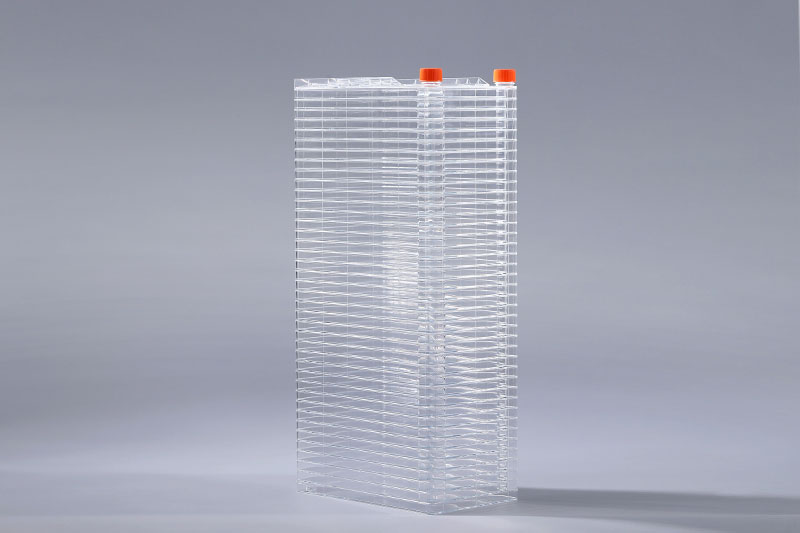सेल फैक्ट्रियांबड़े पैमाने पर सेल संस्कृति में एक महत्वपूर्ण भूमिका निभाते हैं। वर्तमान में, सेल कारखानों के सामान्य विनिर्देश 1, 2, 5, 10, 40, आदि हैं। विभिन्न परतों के अनुरूप संस्कृति क्षेत्र भी अलग है, इसलिए अलग-अलग विनिर्देशों के सेल कारखाने में कितनी कोशिकाओं को टीका लगाया जा सकता है?
प्रत्येक प्रकार के सेल की विभिन्न विकास विशेषताओं और इनोक्यूलेशन घनत्व और पर्यावरण की आवश्यकताओं के कारण, यह सामान्य करना असंभव है कि सेल फैक्ट्री के प्रत्येक आकार के साथ कितनी कोशिकाओं को टीका लगाया जा सकता है। सेल सीडिंग घनत्व से तात्पर्य जीवित कोशिकाओं के घनत्व से है, जो कोशिका वृद्धि और उत्तरजीविता को काफी हद तक प्रभावित करता है। जब टीकाकरण की सघनता कम होती है, तो कोशिका वृद्धि और प्रजनन धीमा होता है, और अंतिम कोशिका की उपज भी कम होती है, विशेष रूप से अनुयाई पशु कोशिकाओं के लिए। जब टीकाकरण की एकाग्रता एक निश्चित महत्वपूर्ण मूल्य से कम होती है, तो कोशिकाओं का विस्तार मध्यम सतह पर भी नहीं होगा। अलग-अलग सेल लाइनों में अलग-अलग उपयुक्त सेल सीडिंग घनत्व होते हैं।
आमतौर पर यह सिफारिश की जाती है कि शोधकर्ता सेल फैक्ट्री के प्रति यूनिट क्षेत्र में कोशिकाओं की संख्या को टीका लगा सकते हैं, इसे इस्तेमाल किए गए सेल फैक्ट्री कल्चर क्षेत्र से गुणा कर सकते हैं, और इनोक्यूलेशन अनुपात से विभाजित कर सकते हैं। सुसंस्कृत कोशिकाएं। बहुत अधिक या बहुत कम कोशिका टीका राशि कोशिका प्रजनन के लिए अनुकूल नहीं है। कोशिकाओं के सामान्य विकास को सुनिश्चित करने के लिए एक उचित कोशिका टीकाकरण राशि एक पूर्वापेक्षा है। सेल कल्चर फ्लास्क की तुलना में, सेल इनोक्यूलेशन की संख्या का विस्तार किया गया है, और बड़े पैमाने पर सेल कल्चर में इसकी भूमिका तेजी से प्रमुख हो गई है।
सेल फैक्ट्रीcell factory uses a multi-layer stacked structure to realize a large area of cell culture in a compact space. Compared with cell culture flasks, the number of cell inoculation has been expanded, and its role in large-scale cell culture has become increasingly prominent.
The FAI climbed 5.9 percent year-on-year in the first 11 months of 2018, quickening from the 5.7-percent growth in Jan-Oct, the National Bureau of Statistics (NBS) said Friday in an online statement.
The key indicator of investment, dubbed a major growth driver, hit the bottom in August and has since started to rebound steadily.
In the face of emerging economic challenges home and abroad, China has stepped up efforts to stabilize investment, in particular rolling out measures to motivate private investors and channel funds into infrastructure.
Friday's data showed private investment, accounting for more than 60 percent of the total FAI, expanded by a brisk 8.7 percent.
NBS spokesperson Mao Shengyong said funds into weak economic links registered rapid increases as investment in environmental protection and agriculture jumped 42 percent and 12.5 percent respectively, much faster than the average.
In breakdown, investment in high-tech and equipment manufacturing remained vigorous with 16.1-percent and 11.6-percent increases respectively in the first 11 months. Infrastructure investment gained 3.7 percent, staying flat. Investment in property development rose 9.7 percent, also unchanged.
 English
English



















































